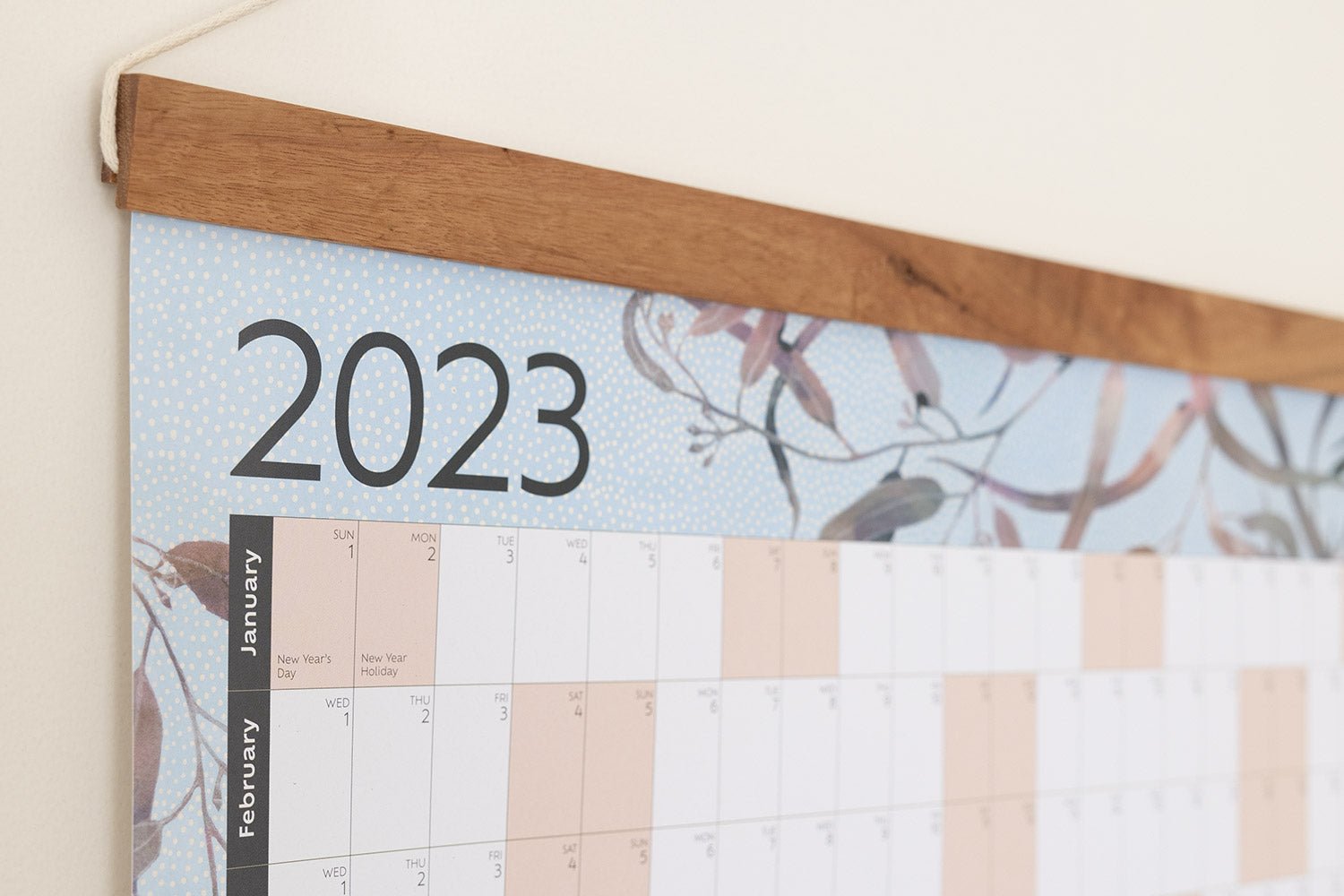For some of us, setting goals and mapping out plans for the new year is all part of the fun and excitement that January brings. We thrive on cracking open a brand new notebook, unfurling a wall planner, grabbing a fistful of coloured pens and getting stuck in.
But, if you’re a reluctant goal-setter, you might be left wondering what all the fuss is about.
Perhaps you really want to set goals for yourself, but every time you try, you feel overwhelmed, anxious and downright fearful. So, you give up.
Or maybe, the mere mention of goal-setting triggers resistance, making you want to roll your eyes, climb the walls or run screaming from the room.
Either way, this one’s for you!
In it, we’ll unpack some of the fears that could be holding you back when it comes to setting goals, and the strategies you can use to overcome the resistance, anger, frustration and avoidance responses these fears create.
The end game? To help you become an enthusiastic goal-setting powerhouse capable of creating and living your best life.
How to identify & flip your goal-setting fears
We’ve got a lot to cover. So, without further ado, let’s dive right in and look at the six main fears people experience when it comes to setting goals and how to overcome them.

1. Fear of failure
No surprise here. This is probably the number one reason why people don’t set goals. It’s an easy trap to fall into. After all, you can’t fail if you never try – right? Wrong! By not trying, you’ve already given in to failure.
This fear often comes from past experience. Perhaps you tried to achieve something that was really important to you and failed spectacularly. The next time you even think about setting another big goal, your brain goes into overdrive: What if you fail again? What if you’re not clever enough? What if you’re not good enough? What if you don’t make it and you’re embarrassed all over again?
While your well-meaning brain is trying to protect you from a repeat of the negative experience you had before, all these negative thoughts and fears not only prevent you from setting new goals, they’ll also rob you of the joy of achieving them.
How to flip this fear
Face your fears
Grab your journal or notebook and write down your goal – even if it scares you. Then write down exactly how you feel about your goal. Don’t sensor or edit your writing, just let it all flow out. Include all the “what if” thoughts that your brain serves up.
Once you have all your fears down on paper, pick through them and pull out any valid concerns from among the unlikely, but nonetheless scary, fears.
Having identified the valid concerns, you can map out and take the necessary steps to avoid these undesirable outcomes. This will go a long way to alleviating your goal-setting fear.
Redefine failure
Realising that failure is not the end of the road for your dreams will also make the process of goal setting a lot less scary.
Even the greatest minds among us fail (often many times over) before they succeed. For example, it took Thomas Edison 1,000 attempts to invent the light bulb.
The difference is that instead of seeing failure as something to be feared and avoided, they embrace their failures as learning opportunities. (And you can too!)
When asked how it felt to fail 1000 times, Edison replied, ‘Oh, I didn’t fail. The light bulb was an invention with 1,000 steps.’
Try this in your notebook or journal: next to every negative “what if” thought you jotted down earlier, make a note of the lesson this failure could teach you.
When you’re ready, you can use your wall plannerto map out the steps you’ll take to achieve your goal.
Psst! Keep an eye out for our upcoming article for more detail on how to use your wall planner to plan your year, maximise productivity and crush your goals.

2. Fear of what others will say about your goals
It can be difficult to share your goals and aspirations with others because, as soon as you do, you’re vulnerable to their judgement and/or rejection.
If you’ve ever told someone about your dreams, and they’ve laughed at you, told you to “get real” or provided you with all the reasons why that could never happen for you, you’ll know exactly how debilitating this fear can be.
How to flip this fear
Accept that haters are gonna hate
Start by realising that whenever you set yourself a big scary goal, there are going to be those who will tell you all the reasons why you can’t do it and why you shouldn’t even try.
Quite often, these well-meaning, if misguided, individuals have experienced some disappointments or setbacks in pursuit of their own goals. They may be trying to protect you from a similar experience. This doesn’t mean you should take their advice and give up on your dreams before you’ve even started.
Grab your notebook or journal write this down: I will not allow other people’s doubts, fears and limited thinking to hold me back from achieving my goals.
Follow this up with some affirmations that will bolster your self-belief. For example, I believe in myself and in my ability to achieve {insert goal here}. Read your affirmations out loud every morning, so they stay clear in your mind.
Find your cheerleaders
Forget the nay-sayers and seek out people who will support, nurture and cheer you on as you pursue your goals.
Make time to regularly connect with these people and use your wall planner to keep track of your catch-up dates and times.
Track & reflect on positive feedback
It’s human nature to remember the negative things people say and forget the positive feedback we receive.
So, write down the positive things these people say about you and your abilities in your notebook and/or journal. Refer to these whenever you need a boost.
Our A6 pocket-sized notebooksare easy to carry around with you, which makes them especially handy for tracking positive feedback.
Lastly, remember what Nelson Mandela said, “It always seems impossible [to you and to others] until it’s done.”

3. Fear of change
Your fear of change is actually part of your brain’s continuous efforts to protect you from taking unnecessary risks.
That’s all fine and dandy while it’s stopping you from heading off into the wild blue yonder unprepared. But, this same fear can also deny you the opportunity to experience new things (e.g., taking that trip abroad or starting a new hobby) and prevent you from reaching new levels of achievement (e.g., applying for your dream job or competing in a sporting event).
How to flip this fear
This is a tough fear to overcome because it’s hard-wired into our brains. In fact, we can become so change-averse that we’d rather be miserable and remain in our comfort zones than venture out in pursuit of happiness. That said, there are ways to conquer the fear of change.
Start with the end in mind
Interrogate your fear of change, and you’ll notice that it’s really the unknown consequences of the change that you’re driven to avoid.
What if this change leads you in the wrong direction? Maybe you’re better off sticking with the status quo – even though you’re frustrated and unhappy with it.
Obviously, this latter is not a great idea. Instead, it’s time to confront your fear. Start by removing the “unknown future” factor.
Set aside about 30 minutes to an hour for this exercise, get comfortable, and grab your favourite journal or notebook and a pen.
Take ten long slow deep breaths to help you relax and clear your mind. Picture yourself 20 years from now. Imagine you had absolutely nothing holding you back, no limits to what you could achieve and where you could go. What would your life look like? Write down everything that comes to mind.
Remember this is your dream, your imagination – anything is possible. Don’t let doubt and fear hold you back and don’t stop writing until you’re done dreaming up your ideal future life in as much detail as possible.
Make small changes over time, rather than big changes all at once
Don’t go trying to make big scary changes all at once. Instead, break things down into bite-sized chunks (mini goals) that are easy to achieve, a lot less scary, and virtually guaranteed to get you where you want to go.
Jot these mini-goals down in your notebook or journal, add dates for reviewing and celebrating your progress. And don’t forget to include rewards for your achievements along the way.
Entering your mini goals, milestones, review and celebration dates on your wall planner will help you’ll feel more in control and less overwhelmed.
Always remember that although moving outside of your comfort zone can be scary, that is where growth and fulfilment happen. So, sometimes you just have to feel the fear and do it anyway.

4. Fear of missing out
Good old FOMO! It’s a powerful motivator to get in on the action for some. But, fear of missing out can also put the brakes on the goal setting process by making it hard for us to choose which goals to pursue.
If you’re spoiled for choice when it comes to opportunities, potential paths to follow and interests you’d love to pursue, you could be just as stuck as someone with a single goal in mind who is too fearful to pursue it.
No matter what you choose, there’s always a sacrifice to be made. If you choose X, then you may not get to do Y. The fear of choosing the wrong one and missing out on the other can lead to you not setting any goals.
How to flip this fear
Accept that you can’t do it all – all the time
The first step in overcoming this fear is to accept that you can’t do and be everything all at once. It’s fine to have a lot of things you’d like to do and achieve, but you only have so many hours in a day, so you need to prioritise.
A good place to start is to have a brainstorming session. Write down everything you can think of that you’d like to do. Add in all your personal, financial, career, relationship, physical and recreational goals. Use one of our stylish Cup Notes notebooks where the covers are made from a mix of recycled coffee cups, and you’ll be helping to save the planet too!
Decide what’s most important to you now and focus on that first
Next up, you need to get really clear about what’s most important to you (your values) and pick the goals and aspirations that align most closely with those values.
For example, if you’d like to run an ultramarathon and learn to play the ukulele and write a novel and learn a new language and get a promotion at your very demanding job. There’s no reason why you can’t do all those things. But, since they all require a considerable amount of time and effort, it’s very unlikely that you’ll be able to accomplish all of those goals simultaneously. So, you’ll need to prioritise them according to your current set of values.
If you value your ability to provide for your family and the promotion at work will help you to secure a loan on your first home, you may want to prioritise that goal for now, while keeping the others on the back burner until you’re ready to tackle them.
Use your wall planner to track your progress and record deadlines for your goals and quash your FOMO by marking off goal renewal dates where you can revisit your brainstorm list, cross off the goals you’ve achieved, and pick new ones to tackle.

5. Fear of success
As weird as that sounds, it is actually a thing, and it’s also part of your brain’s protection system.
If you don’t try, you can stay in your comfort zone and keep things nice and steady – just the way your brain likes it. If you try and succeed everything’s going to change – and that makes your brain nervous!
Surely, things are fine just the way they are. No need to aim higher. Don’t want to rock the boat.
This fear stems from a deep-seated limiting belief that you cannot go beyond a certain self-imposed upper level of success. This leads you to self-sabotage every time you try to reach a new level of achievement in your life.
At the heart of these limiting beliefs lies the fear that you will not be good enough or capable of handling the tasks and responsibilities that accompany the new level of success.
How to flip this fear
Challenge limiting beliefs
You can challenge limiting beliefs by examining how far you’ve already come. Open a fresh page in your journal and make a list of the things you’ve accomplished in life and the new skills you’ve acquired along the way. It won’t take long to make a compelling case that you are, in fact, equipped to successfully handle the challenges and responsibilities that come with success.
Now get out there and shoot for the moon! As Norman Vincent Peale said, ‘Even if you fail, you’ll land amongst the stars.’
Start by setting milestones and dates for achieving your successes and marking these off on your wall planner so you can track your progress.

6. Fear of appearing ungrateful for your current life
Perhaps you’re concerned that if you start setting goals, you’ll appear ungrateful for the level of success you’ve already achieved. Or maybe you feel that by aiming higher, you might become discontent with what you have?
How to flip this fear
Consider how you got to this point
As much as this is a valid fear, you can flip it by looking at how you got here in the first place.
If you take some time out with your notebook or journal and consider all the steps along the way, chances are you’ll see that you got to where you are now by setting and achieving goals (even if you did this more or less on autopilot). Since you set goals and remained grateful up to this point, you’re likely to continue to do so.
Proceed with a grateful heart
Keeping a gratitude journal is a sure-fire way to allay any fears that goal-setting might lead you to be ungrateful. If you’re regularly journaling about the things you’re grateful for, you’ll be free to set and achieve any goals you desire, while still maintaining an attitude of gratitude.
Now that you’re equipped to deal with your goal-setting fears, it’s time to get planning for the year ahead !
Allow yourself to BREATHE and set new goals with a stunning A2 portrait wall planneror our new larger A1 landscape planner.
Made from 100% recycled, FSC-certified card, these planners are light on the environment and designed by Gold Coast artist Maia Green. The layered leafy textures will bring a breath of fresh air into any room. Plus, they’ll help you set yourself up for success!

![Spearmint A6 Pocket Notebooks [BULK 8 PACK] - Notely Lined](http://notely.com.au/cdn/shop/products/spearmint-a6-pocket-notebooks-bulk-8-pack-notely-399099_1600x.jpg?v=1699275130)








